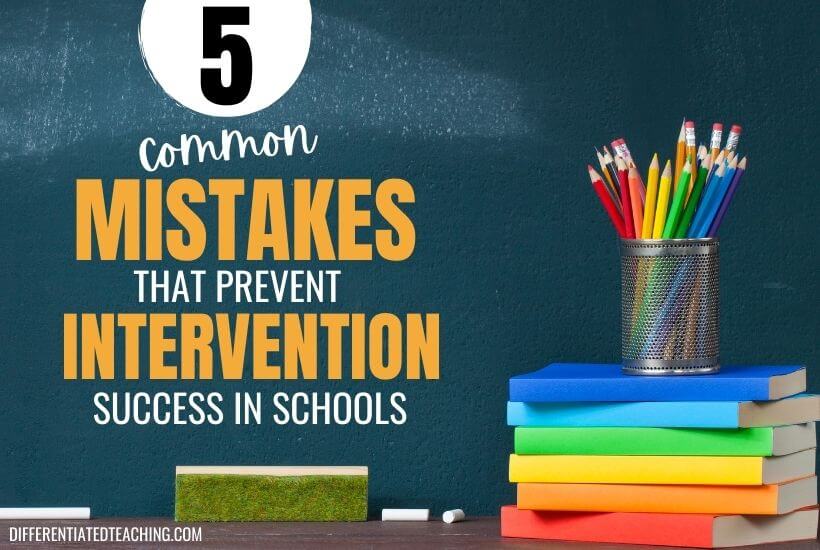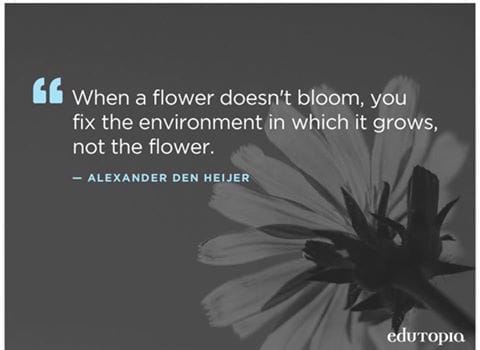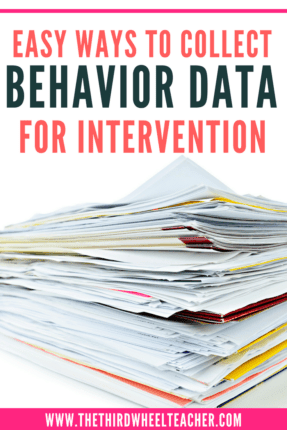Is your campus making these RtI mistakes?
The other day I read an article in Education Week about Response to Intervention falling short of expectations. I wasn’t at all surprised to read this. However, I was scared. Scared that my colleagues and schools around our country were about to throw intervention out with the bathwater.
Scared that kids were still falling through the cracks.
Scared what politicians and bureaucrats…and even parents…were going to do with this information.
You see, I believe in RTI. I have seen it do amazing things for struggling learners. I know it works. I also know that way too many schools are doing it wrong.

Even the best tool or structure, when not used correctly isn’t going to work as expected. At the same time, I don’t think anyone is doing it wrong on purpose. Nearly every teacher I know wants to help kids. They want to see those struggling learners succeed…so why is it going so poorly?
In my opinion, there are 5 big mistakes that are happening across the board. Fixing these mistakes could make a huge difference in the outcomes for kids, but it is up to schools and districts to take the initiative to do it.
Mistake 1: Poor training for Tier 1 supports.
This is a huge problem because it impacts the foundational level of the system. The vast majority of teachers are never given training on documenting and implementing Tier 1 interventions in their school districts.
I am lucky enough to have a degree in school psychology from a school that pushed for school psychologists to have a role in intervention planning and implementation. However, had I not had this experience, I would have been up a creek without a paddle. Without an understanding of what to do, we are all just left to figure it out for ourselves.
This creates issues at multiple levels. First, many teachers come to RtI meetings without the necessary data to help the team make effective decisions. When teachers can come to these problem-solving meetings with a better understanding of what is expected, it is easier for everyone.
Training teachers in what level of supports and monitoring should be in place is a great first step, but this must also be done in addition to making sure everyone is trained and has time to implement the core curriculum.
Mistake 2: Intervention specialists are pushed beyond their expertise.
Many interventionists leave the classroom because they are tired and overwhelmed.
They are good teachers and are ready for a break. Then they are given intervention groups in areas that are so far out of their expertise. For example, a fifth-grade teacher turned interventionist given a group of beginning readers. Well, unless they have experience with phonics, phonemic awareness, and the foundations of reading, it just can’t go well.
It is important that interventionists continue their training and seek out opportunities to join groups of like minded educators who are supporting struggling students and keeping up to date with the latest research.
Mistake 3: There’s a major issue with data.
I firmly believe this is a two-fold issue. First, we don’t have the right data. Secondly, we don’t know how to use it for RTI purposes.
Problem: We’re missing key data on struggling learners.
For years there have been a plethora of reading tools. However, math tools are still rather slim pickings. By now most campuses conduct universal screening, but after the screener should come some diagnostic testing for those kids who fall in the danger zone.
The goal of these diagnostic assessments is to discover WHERE the student is struggling so we can start effectively intervening. Without the diagnostic tool, it becomes a shot in the dark for most teachers.
When we rely on unit tests or other materials like these, we fail to really get to the root of the issue. How many kids do you know that fail every single unit test?
It is hard to look at where the gap is based on discreet skills that are never examined together. A diagnostic tool would give us insight into where the initial break down occurs so we could begin from the beginning.
Problem: Too much time is being spent assessing advanced learners.
Your universal screening data can be an important piece of information to help you identify the next steps in identifying who needs more assessment and who doesn’t. However, many campuses and entire districts are giving EVERY. SINGLE. STUDENT. the BAS or DRA three times per year. They argue this data is useful to put kids into reading groups.
If you’ve ever given these assessments to 24+ students you know what a huge time commitment that is. These tools are designed to give data on accuracy, fluency and comprehension. While they aren’t perfect, they are designed to help you target weaknesses and set goals for intervention.
Your most advanced learners most likely do not need a diagnostic assessment 3x per year. Yearly monitoring is plenty as long as they stay on their well-above average trajectory. The time spent monitoring these students is better spent providing instruction across the board.
I always relied on other tools to help me find where the gap is in my student’s abilities instead of taking the diagnostic and using that information to help me. I look back and think about all my wasted time!
Mistake 4: There’s a lack of targeted focus.
This one is the biggest issue. A student should never be in reading intervention. That isn’t good enough…and it wastes time with kids who do not have time to waste.
If we were better at targeting the specific gap, the student could get support on the skill that is holding back their success.
I’m not a proponent of programs like Read 180 and LLI for this reason. They are comprehensive reading programs.
By the time a student needs Tier 2 they don’t need more comprehensive reading. They need an intervention laser-targeted toward the skill gap keeping them from progressing.
Many kids are struggling with reading, for example. Break it down, you’ll discover they are spending so much effort decoding that it is no wonder they aren’t understanding.
Now dig deeper.
Why are they reading slowly?
Are they accurate? If not, then your best bet is to intervene to build accuracy. Once they’re accurate, you can work to build fluency…and then comprehension.
In math this gets harder, but the idea remains.
If a student can’t add, they won’t be able to solve addition word problems.
We try to maximize intervention time by covering everything, but if we focused on filling the basic skill gap it would become like a rock rolling down a hill.
Yes, a student might have many gaps.
Yes, they might need several rounds of intervention supports. However, if we don’t fill the foundation we are building a bridge over the Grand Canyon and hoping it doesn’t collapse.
Mistake 5: It’s also a people & resources issue.
It’s still the road to getting the kid off our plate…whether to intervention or special education.
By the time kids are referred for Tier 2 support, most teachers have cleared their toolbox. They don’t know what else to do. The idea of washing our hands of a kid isn’t because we don’t want them to succeed…its the opposite really. We just don’t know what else to do so we pass them off to someone else who we trust does.
This isn’t working.
Instead, we need to sit down together during those Student Support Team (SST) meetings and get to the core of the issue.
We need to set goals and decide who is going to monitor them and with what tool. We need to build our capacity to work with the student at Tier 1 and then add more focused work at Tier 2, when intervention specialists are available to help. By building classroom teachers’ toolboxes through SST meetings, we will start to see the number of kids referred for support decrease.
By building classroom teachers’ toolboxes through SST meetings, we will start to see the number of kids referred for support decrease.
Educational Assistants are providing intervention to our most struggling students.
I will be the first to say there are a number of amazing EAs (paras for those of you who prefer that terminology). I’ve worked with several that are MORE qualified to intervene for some skills than the interventionist or classroom teacher. However, I’ve also seen a lot that
However, I’ve also seen a lot that were thrown into the mix, assigned intervention groups, told to progress monitor…and never talked to again.
Shouldn’t our struggling learners be working with our strongest, most skilled teachers? If I am struggling to breathe, I don’t go to the CNA living down the street from me. I go to the ER or a see specialist. The students don’t know who is most qualified. They just know they need extra help. It is up to us to make sure we are giving them the
If I am struggling to breathe, I don’t go to the CNA living down the street from me. I go to the ER or a see specialist. The students don’t know who is most qualified. They just know they need extra help. It is up to us to make sure we are giving them the
The students don’t know who is most qualified. They just know they need extra help. It is up to us to make sure we are giving them the best-matched support available.
This might mean that an EA covers a classroom or duty while a rock star reading teacher provides intervention. It might mean the librarian pitches in because she has a certificate in math intervention. Whatever it takes, we have to make it work.
 Can Response to Intervention be fixed?
Can Response to Intervention be fixed?
I think so…but it is going to hurt a bit at first. If we want intervention to work, we need to get better at doing it. We have to stop talking about how to change the students and start talking about how we change the environment. We are missing the point if it comes down to just the student. The solution is in the bigger picture. I love this quote I saw on Edutopia the other day, and I think it fits perfectly here.
Of course, we also need to stop having standards that are an inch deep and mile wide and to start letting teachers teach, but that’s a story for a different day.


 Can Response to Intervention be fixed?
Can Response to Intervention be fixed?




